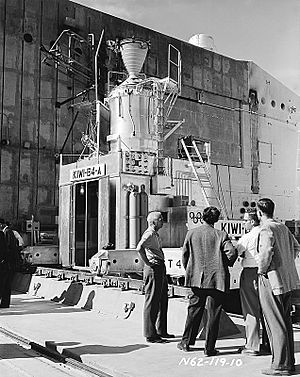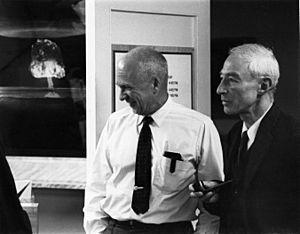Norris Bradbury facts for kids
Quick facts for kids
Norris Bradbury
|
|
|---|---|
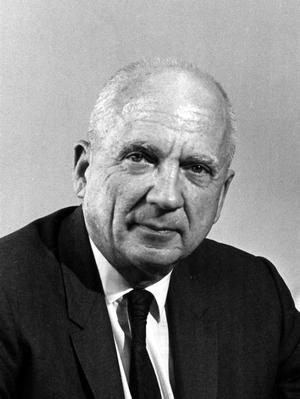 |
|
| Born | May 30, 1909 |
| Died | August 20, 1997 (aged 88) |
| Citizenship | United States |
| Alma mater | Pomona College (BA) University of California, Berkeley (PhD) |
| Known for | Succeeded J. Robert Oppenheimer as Director of the Los Alamos National Laboratory |
| Awards | Legion of Merit (1945) Department of Defense Medal for Distinguished Public Service (1966) Enrico Fermi Award (1970) |
| Scientific career | |
| Fields | Physics |
| Institutions | Stanford University University of California Los Alamos National Laboratory |
| Thesis | Studies on the mobility of gaseous ions (1932) |
| Doctoral advisor | Leonard B. Loeb |
| Signature | |
Norris Edwin Bradbury (born May 30, 1909 – died August 20, 1997) was an American physicist. He is best known for leading the Los Alamos National Laboratory for 25 years, from 1945 to 1970. He took over from J. Robert Oppenheimer, who personally chose Bradbury for the job.
Bradbury worked closely with Oppenheimer on the Manhattan Project during World War II. This secret project developed the first atomic bombs. Bradbury was in charge of putting together "the Gadget", the first atomic bomb ever detonated. This happened in July 1945 during the Trinity test.
After the war, Bradbury faced a tough challenge at Los Alamos. Many scientists were leaving, and living conditions were poor. There was even a chance the laboratory would close down. But Bradbury convinced enough staff to stay. He also got the University of California to continue managing the lab. He pushed for new and better nuclear weapons, making them safer and easier to use.
In the 1950s, Bradbury also oversaw the creation of thermonuclear weapons (hydrogen bombs). Later, he expanded the lab's work into other areas. He helped build the Los Alamos Meson Physics Facility for nuclear science. During the Space Race in the 1960s, his lab developed the Nuclear Engine for Rocket Vehicle Application (NERVA). This project explored using nuclear power for rockets. The Bradbury Science Museum is named in his honor.
Contents
Early Life and Education
Norris Bradbury was born in Santa Barbara, California, on May 30, 1909. He was one of four children. He went to Hollywood High School and Chaffey High School in Ontario, California. He graduated at age 16.
He then attended Pomona College in Claremont, California. In 1929, he graduated with top honors in chemistry. He became interested in physics and continued his studies at the University of California, Berkeley. He earned his PhD in 1932. His research focused on how ions move in gases.
While at Berkeley, Bradbury joined the Naval Reserve. After two years at the Massachusetts Institute of Technology, he became a physics professor at Stanford University in 1935. He became an expert on how electricity moves through gases and the properties of ions. He even invented a special electrical gate called the Bradbury-Nielsen shutter, which is still used today in scientific instruments.
World War II and the Atomic Bomb
In 1941, Bradbury was called to serve in World War II. He worked for the Navy on how bullets and bombs fly. In June 1944, he received orders to join the secret Manhattan Project in Los Alamos, New Mexico. He was asked to work on special explosives needed for the atomic bomb.
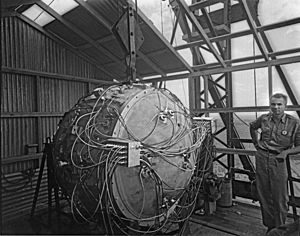
At Los Alamos, Bradbury became the head of a group that tested the implosion process. This was a critical part of making the bomb work. In March 1945, he was put in charge of assembling the "Fat Man" bomb.
In July 1945, Bradbury supervised the final preparation of "the Gadget" for the Trinity nuclear test. This was the world's first test of an atomic bomb. Bradbury later said he was simply "damned pleased that it went off."
Leading Los Alamos Laboratory
After the war, J. Robert Oppenheimer resigned as director of the Los Alamos Laboratory. The head of the Manhattan Project, Leslie R. Groves, Jr., asked Oppenheimer who should take over. Oppenheimer recommended Bradbury. Groves agreed, partly because Bradbury was both a scientist and a naval officer. Bradbury accepted the job for a six-month trial.
Bradbury was officially discharged from the Navy and received the Legion of Merit award for his wartime service. On October 17, 1945, he became the second director of the Los Alamos Laboratory.
His first months as director were very hard. Many scientists wanted to go back to their old jobs at universities. By early 1946, most of the wartime leaders had left. The number of staff at Los Alamos dropped from over 3,000 to about 1,000. Living conditions were also difficult, with problems like frozen water pipes. Despite these challenges, Bradbury still had to support nuclear tests in the Pacific.
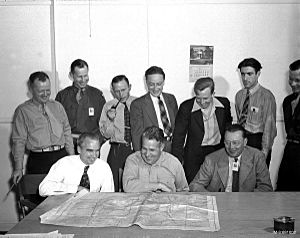
Bradbury pushed for continued development of nuclear weapons. He wanted to turn them from experimental devices into reliable production models. Many improvements were made to make them safer, easier to store, and more efficient. While he focused on improving existing atomic bombs, research also continued on the "Super" (a thermonuclear weapon or hydrogen bomb). New atomic bomb designs were tested in 1948. The Mark 4 nuclear bomb became the first atomic weapon to be mass-produced.
Bradbury also worked to find a new, better location for the laboratory away from the crowded town center. He proposed building a new facility. The University of California had been managing the lab under a wartime contract. Bradbury convinced them to renew the contract in 1948. In 1951, he became a professor at the University of California.
By 1951, the lab had developed the Teller-Ulam design for the hydrogen bomb. Tests were conducted during Operation Greenhouse. There were some disagreements between Bradbury and Edward Teller about how much priority to give to hydrogen bomb development. This led to the creation of a second nuclear weapons lab, the Lawrence Livermore Laboratory.
In later years, Bradbury expanded the lab's work. He oversaw the building of the Los Alamos Meson Physics Facility to advance nuclear science. During the Space Race of the 1960s, the lab worked on Project Rover. This project developed the Nuclear Engine for Rocket Vehicle Application (NERVA), showing that nuclear power could be used for rockets.
For many years, Bradbury was also in charge of running the town of Los Alamos. The town developed excellent health and education facilities. Eventually, a new technical area was built outside the town. In 1957, the security gates were removed, and the town became its own community. This ended Bradbury's responsibilities for the town.
In 1966, Bradbury received the Department of Defense Medal for Distinguished Public Service. This award recognized his "exceptionally meritorious civilian service" as director of Los Alamos. He also received the Enrico Fermi Award in 1970, a very high honor in science.
Later Life
Norris Bradbury retired as director of Los Alamos Laboratory in 1970. His successor, Harold Agnew, asked him to stay on as a consultant, but Bradbury declined. However, he did serve as a consultant for other government groups and was a member of several local boards.
In 1969, the governor of New Mexico appointed Bradbury to the board of the University of New Mexico. This was a difficult time for the university. In 1970, students protested the Kent State Shootings. The governor called in the New Mexico National Guard, and some people were injured. The next governor replaced Bradbury and another board member.
In the mid-1990s, Bradbury had an accident while chopping firewood. He developed a serious infection, and part of his right leg had to be removed. The infection spread, and he eventually died on August 20, 1997. He was survived by his wife, Lois, and his three sons. He was buried in Los Alamos.


